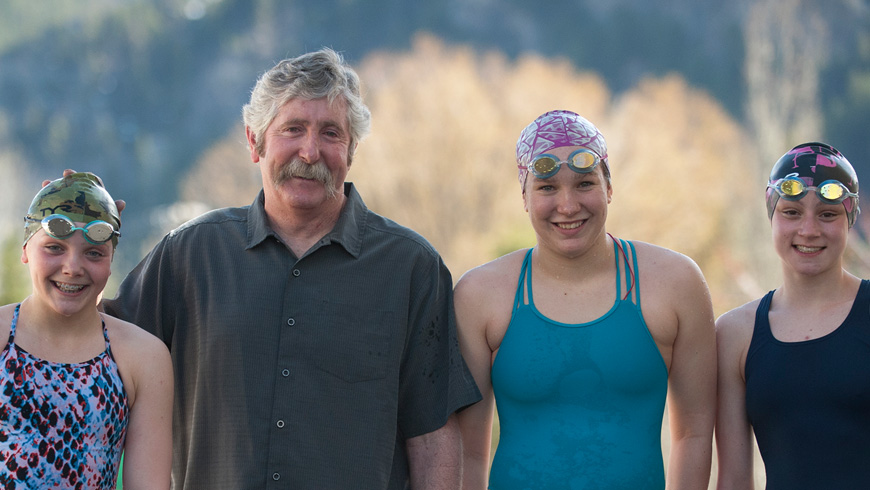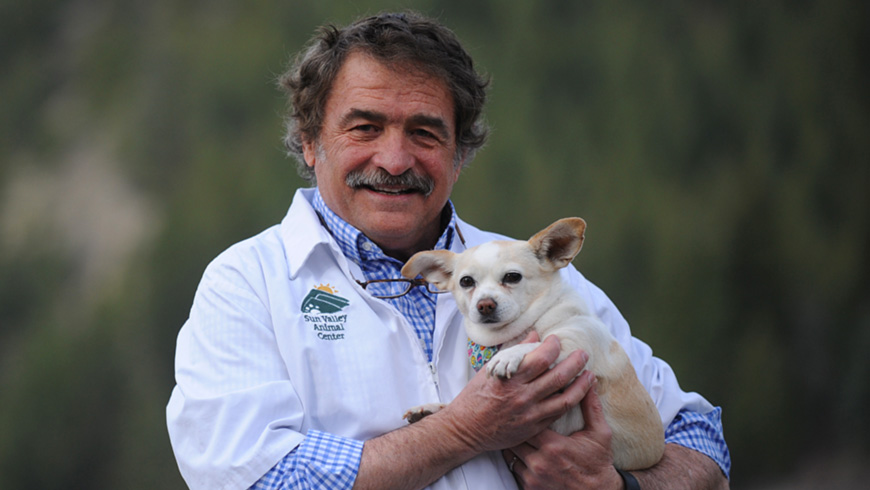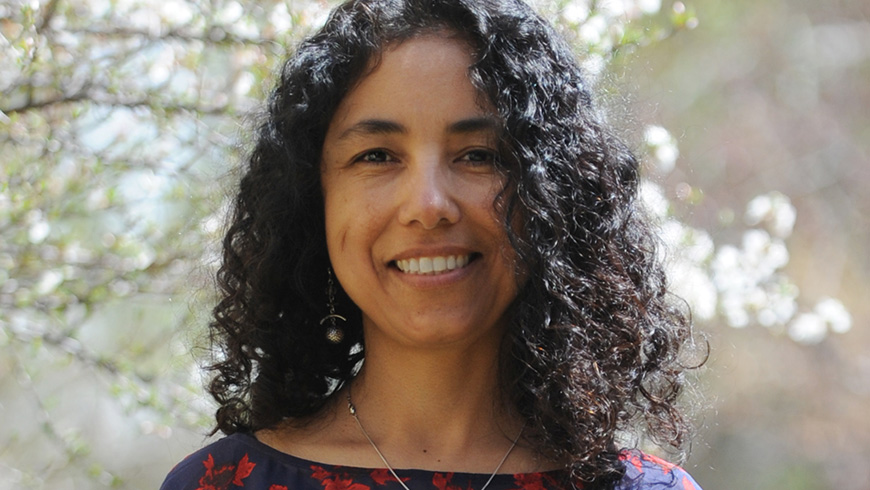Brian Gallagher
While Hailey’s Brian Gallagher considers swimming a superior aerobic workout to many other activities, he also points out that he “…loves the feeling of ‘how’ you move through the water. Swimming is meditation in the moment,” he says. “While training you have to pay attention to every movement of each part of the body in every moment so that you are prepared when it’s time to compete. Competitive swimming is a great way for young people to learn about living a good life.”
And competitive swimming is something Gallagher knows a little bit about. He began competitive swimming in 1961 at the age of 6. He has been a professional swim coach since 1976 and today is the coach of the Sun Valley 5B Swim Team and one of the most accomplished coaches (and Masters Level competitive swimmers) in America. He has twice been named American Swimming Coaches Association Coach of the Year; he has garnered five consecutive Wood River High School Girls State Championship wins; been named USA/Snake River Swimming Coach of the Year three times and Idaho High School Swimming Coach of the Year twice. He received the USA Swimming Outstanding Service and Lifetime Achievement Award and among a long list of competitive accomplishments are several U.S. Masters National first-place awards and two Masters World Championship titles. Although Gallagher has competed in all four swim strokes, his preferences lean toward the backstroke, individual medley, and longer open water distances.
Born in 1954 and raised in Phoenix, Ariz., Gallagher attended Brophy College Preparatory, a Jesuit all-male high school that ”…strives to educate the whole person through rigorous academics and innovative technology, through outreach and service, and through retreats and personal reflection. In the Jesuit tradition, Brophy graduates ‘Men for Others’…leaders in the global communities they serve.” After Brophy, Gallagher attended the University of Arizona, graduating with a degree in English Literature and a minor in Latin. All through his school years he swam competitively and played water polo (a member of Arizona’s NCAA Championship team in 1975 and 1976). He also played basketball and baseball and was a recreational skier. After graduation, he coached swimming and water polo in Phoenix, as well as coaching Arizona State University’s water polo team.
Then, in 1978, looking for new horizons, Gallagher came to Sun Valley to spend a season skiing before moving on to whatever life offered. A year in Sun Valley morphed into a lifetime of much more than skiing. Gallagher and his wife Julie own a home in Hailey and have been together for 31 years. He works construction full-time and coaches swimming, skiing, hiking and fly-fishing whenever he can.
As a leader in the community he serves, Gallagher’s life is busy. After each construction day is finished, he coaches four hours of swimming in the summer and about two and a half hours a day in the winter. And weekends are often taken up by travelling with his team to swim competitions. He estimates that he has probably coached over 1,000 boys and girls between the ages of 8 and 18 in his career, usually in groups of 25 to 30.
He laughs when he says, “I’m probably one of the few swim coaches in the country who doesn’t care if the kids ski. Most of the kids who swim here have learned to ski or board or play hockey; they enjoy it, and it’s good for them.” Smiling, he adds, “Kids who have worked hard and had good results with a smile on their faces is my reward for what I do.”
—By Dick Dorworth
Ann Christensen
Ann Christensen was born 84 years ago in Louisville, Kentucky, where she lived until 1952 when she attended Smith College in Northampton, Mass., to study history, art and English. Those were common subjects of study for proper, conservative, Republican, Southern women of the time. She remembers the curriculum required her to take a course in zoology. Christensen also learned to ski at Smith. Today, the college website reads, “A Smith education will push you beyond your intellectual passions. You’ll delve deeply into the world of ideas. You’ll discover what inspires and empowers you.”
Christensen has well used her Smith education.
After receiving her B.A. in history, Christensen went to work for Proctor and Gamble in Cincinnati as a market researcher. The job entailed travel all over the United States. A couple of years later, she took a leave of absence to travel in Europe. In December 1959, she was skiing in Alta, Utah, one weekend and met Doug Christensen in the Rustler Lodge Bar. Six months later they were married and she moved to Marin County, Calif., where Doug lived, a long way from Kentucky.
“As a Southern Republican, I had to learn how to vote in California,” she says. She had been naïve about politics and had always trusted the establishment, but the big political issue in Northern California in 1960 was the California Water Plan that meant diverting water from the California Delta to Southern California. This and other environmental issues were the beginning of Ann’s political education and the radicalization of her belief system.
Doug and Ann became leaders of the local environmental movement and had two daughters, Eloise and Aimee. They loved hiking and exploring Yosemite and the many scenic areas of Northern California and found that with two young children the Sierra Club Wilderness Threshold trips offered a great way for families to enjoy the backcountry. They became trip leaders and active club members and participated in a values clarifying workshop.
Marin was an exciting place to learn about nature with children, and Ann became a docent at Audubon Canyon Ranch and the Richardson Bay Sanctuary. She took most of the science classes the College of Marin offered, and the family joined her on weekend trips in field botany. Doug became the first male member of the Marin environmental forum. Meanwhile, Ann earned elementary and secondary school teaching credentials from Dominican College in San Rafael and began her long history of introducing and teaching generations of children and adults about the wonders of nature.
In 1983, Doug retired from his building contractor business, and the Christensen family moved to Ketchum. Doug and Ann established the Christensen Family Foundation “…to protect the environment and to increase social justice,” and they have been honored with more environmental and social awards than can be mentioned here. The Sun Valley Institute website describes Ann: “As a teacher and educator, she shares her love for the area’s natural world, helping others to fall in love with it and to preserve and restore it. Ann is well known by generations of children and adults who have been introduced to the wonders of nature in her Science Time classes at The Community Library, her Ants and Plants summer classes for the College of Southern Idaho, and her animal tracking workshops in the winter for the Environmental Resource Center. She has a long history of teaching in schools and volunteering for environmental and educational groups in Idaho and California, including working tirelessly for Idaho’s salmon and wolves. She has served on numerous boards of directors, including the Greater Yellowstone Coalition, The Community Library, Light on the Mountains Spiritual Center, Community School Parents’ Association, and was a founding board member of the Environmental Resource Center.”
Ann says her activism “…grew out of my love for and curiosity about Mother Nature. I saw the need to reach children at an early age and expose them to the wonders that surround us. I love teaching the most and the learning that goes with it. I see so much that we need to do to ensure a rich environment for the next generation.
–By Dick Dorworth
Dr. Randy Acker
Since 1982, Randy Acker has been the owner and medical director of Sun Valley Animal Center just south of Ketchum, where he specializes in medical and surgical care for sporting and working dogs. In particular, Acker focuses on orthopedic surgery, a skill that has made him and the Animal Center a national referral resource for some of the most difficult orthopedic surgical procedures. In fact, Acker is nationally known for developing an artificial canine elbow called the TATE Elbow Replacement System for dogs and credits his own yellow Labrador retriever Tate for inspiring him in coming up with the invention.
“My dog Tate was so limpy with elbow dysplasia that I got frustrated,” said Acker. “There had been 13 attempts around the world to create an elbow, but they didn’t work very well.”
So, Acker hired Valley resident Greg Van Der Meulen, who was working on his degree in mechanical and biomedical engineering at Colorado University Boulder, to help in the design. It took several years, but finally in 2007 Acker implanted the first TATE elbow. He is still the leader in the world for the procedure, performing at least one elbow surgery each week.
In addition, Acker and Van Der Meulen teamed up again in 2015 to develop the first canine ankle replacement and has thus far implanted the first 10 artificial ankles in the world on dogs.
Saving a Tiger
The medical challenges come “all day, every day,” Acker said. “Really bad broken legs and spinal injuries. I get the really bad stuff because nobody else wants to do it. We do 85 percent referrals from out of town that nobody wants, like a blown-up femur on a tiger from Bozeman.“
The tiger Acker referred to is Shekinah, a rare 8-year-old white Bengal belonging to Montana illusionist Jay Owenhouse. Shekinah had broken her femur in a fall and, rather than putting her down, Owenhouse searched nationwide for the top veterinary orthopedic surgeon to hopefully reconstruct the cat’s broken leg. Acker got the call.
In preparation for surgery, Acker consulted with Saint Alphonsus Hospital’s director of orthopedic trauma, Dr. David Zamorano, who concluded that fixing the tiger’s femur would be like repairing a human’s leg.
A team of surgeons and equipment from Boise, an anesthesiologist from Montana and Acker’s veterinary team gathered in the Sun Valley Animal Center operating room for more than three hours to implant a titanium rod into the cat’s femur.
“I’m not certain, but it may be the only tiger ever done like that,” said Acker, who has also operated on bears, cougars, wolves, deer, llamas, eagles and others. “I was so relieved to get it done. The tiger is very special. You don’t feel like you should be cutting through them. There’s a feeling when you work on a beautiful wild animal like that, almost a strange sense that you’re not supposed to be meddling in that area.”
A Family Affair
For Acker, veterinary medicine is a family affair. “My brother, Mark Acker, DVM, has been involved in the Bellevue Sawtooth Animal Center for many years. He was the first to join the team,” he said. “My brother, Scott Acker, DVM, and I worked together for many years, and now he runs the downtown Ketchum Sun Valley Animal Center. My daughters Amber Acker-Sanborn, DVM, and Maggie Acker-Buck, DVM, both work with me at Sun Valley Animal Center.”
And not to be left out, his wife, Sue Acker, is also a full-time employee of the Sun Valley Animal Center in the management end of the business.
Fixing Loved Ones
Acker’s philosophy is that pets are meant to be enjoyed and not be a burden. “They bring us a gift, and I think when it’s time to go, it’s time to go. I see people hang on a bit too long and veterinarians do all sorts of things at the end of life that they shouldn’t. We need to tell owners that it’s okay to let them go and that the dog would thank them for letting them go and for giving them a good life.
“I really love my job. Every night I go to bed and think, ‘Wow I helped that dog and his owner. I get to fix people’s loved ones and give them back to them every day.’”
—By Patti Murphy
Raquel Galvin
Raquel Galvin has worked at The Advocates for 17 years. Wait, Galvin who? Exactly.
Galvin is a critical pillar of our community of whom the general public may never have heard but who is the ever-steady bright light in the lives of hundreds of women in Idaho and beyond. She is a local hero.
Serving as client programs director and bilingual advocate, Galvin quietly and unwaveringly supports survivors of domestic violence and sexual assault, helping them rediscover their voices and inner strength. “This job is not for everyone,” she shared recently. “It’s hard, but I love it. My passion is working alongside women in their suffering and teaching them skills to change their lives. My job is to support women in realizing there is more to the life they have and beauty out there.”
Galvin’s interest in working with women was sparked by her inspiring mother who grew up on a farm in Peru and was strong, hard-working, and believed education was essential to a purposeful life. Her mother’s determination, coupled with her father’s incredible knowledge (“he was an open book,” Galvin noted), were the perfect recipe for an oldest daughter who did not want to adhere to the traditional norms or expectations of Latina women. Galvin was fearless and curious, and she poured herself into books and adventure around Lima. “Lima taught me to be street smart. As a young woman, I was a target and I had to always pay attention. But I was curious. I didn’t want to sit in front of a TV. I wanted to go out and explore.”
Galvin’s love of learning has been evident throughout her career. She graduated from high school at 16, went to a two-year secretarial school, worked for four years as a secretary for an import-export company in Lima, and then earned a six-year degree as a clinical psychologist at The Universidad de San Martín de Porres. While she was inspired by her work, she was discouraged by the contamination, crowds, and chaos of city life. She kept an eye out for clinical positions in the countryside.
In 2000, Galvin’s dream of living in the countryside became a reality when she moved to Fairfield, Idaho, with her husband, Pat Galvin, whom she met on the Internet. Pat was shy. “If I didn’t do the talking, I wouldn’t be here,” Galvin giggled. Pat traveled to Lima to meet her, and they fell in love. The move was a transformative experience for Galvin. “It helped me relax,” she said. “Everyone was so welcoming in Fairfield. I wasn’t used to talking to strangers in Lima. But here, everyone smiled. I also loved the openness and the green.” Soon after, Galvin secured a job with The Advocates.
Since then, Galvin has been a magical source of transformation for hundreds of women at The Advocates and also an incredible coach and mentor to many new advocates. Her daily mission is for each woman with whom she works to remember she is not alone and has rights. Of course, the burnout is real, and when Galvin is tired and stressed, she finds renewed energy reading books at the Hailey Public Library, gardening, and laughing at herself. “Humor is important,” she said. But she also reminds us that the survivors who come to The Advocates are inspiring and strong, and, in turn, give her renewed energy and commitment.
When asked how many women she has worked with, Galvin reflected, “Some people work on their careers and statistics about their careers, but I just want to be the little mouse in the corner having meaningful experiences with each individual.”
–By Winslow Brokaw





